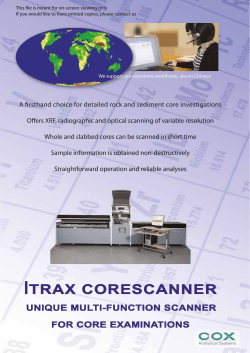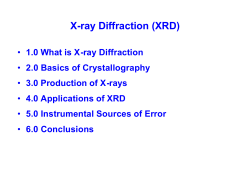
Portable X-Ray Fluorescence to Determine the Composition of Household Objects
Portable X-Ray Fluorescence to Determine the Composition of Household Objects Katherine A. Spoth Department of Physics, SUNY Buffalo, Buffalo, New York, 14260 (Dated: August 13, 2010) The portable X-ray fluorescence setup that has been developed at the Cornell High Energy Synchrotron Source has a number of useful applications. Developed for the main purpose of outreach and teaching, it can be used to quickly determine the elements that make up a sample. This is useful in introducing visitors to the lab to XRF in a way that is interesting and easily understandable. The efficiency with which the components of a sample can be determined also makes the setup useful for finding the components of household objects. The setup was used to collect spectra from about one hundred different objects that the body often comes in contact with; these spectra were analyzed to determine the composition of each sample. I. INTRODUCTION CHESS has developed a mobile setup for performing X-ray fluorescence (XRF) measurements, mainly for the purpose of outreach and teaching. XRF is a useful introduction to X-ray physics because it is a method that is simple to explain and quick to carry out; a sample’s composition can be determined within a matter of minutes. The ease with which the elements present in a sample can be found also makes this setup useful for analysis of the components of everyday objects. The inspiration for this project came from a study of children’s face paints that found all of the paints tested contained lead while some of the samples also contained heavy metals such as chromium, cobalt, and nickel[1]. These materials are dangerous when absorbed through the skin, especially to children. The portable XRF unit has been used to test common household items such as cosmetics, jewelry, and small toys to determine if they also contain similar hazardous materials. II. A. METHOD XRF Description In XRF, a sample to be analyzed is bombarded with X-rays from a source, an X-ray tube in the case of this portable setup. If these incident X-ray photons have energy higher than the binding energies of inner shell electrons in the sample, these electrons may be ejected from atoms that make up the sample. Outer electrons may then fall to fill the vacancies left by the escaped electrons, releasing radiation in the process. The energy of this released radiation is equal to the energy difference between the electron’s original outer shell and the inner shell it falls to. This release of radiation is what is known as X-ray fluorescence. Since each element has unique differences between its energy levels, each will emit characteristic lines at these energies. Therefore, the peaks that appear in a spectrum can be analyzed to determine their source elements. 2 FIG. 1: The entire XRF cart. The X-ray source, sample, and detector are all contained in the lead acrylic enclosure on top of the cart. The digital pulse processor and a computer are also located in the cart; collected spectra are displayed on the monitor. B. Setup The portable XRF setup at CHESS has three main components: an X-ray source, detector, and digital pulse processor. The source is an Amptek Mini-X X-ray tube[2]. The tube produces X-rays by accelerating electrons through a high potential difference (10-40 kV) toward a silver target, which then fluoresces and emits X-rays at its characteristic energies, most strongly at 22.16 keV. The electrons lose energy and decelerate in the silver target, which emits a continuous spectrum of X-rays known as Bremsstrahlung or “braking radiation”. A filter can be used to decrease this background in certain regions of the spectrum and improve the signal to noise ratio, making it easier to distinguish elements’ characteristic peaks from the background. Aluminum and tungsten filters have been used in this project when collecting spectra, and other filters made of copper, molybdenum, and silver are also available for use. The X-ray detector used is an Amptek XR-100SDD[4], a silicon drift detector. Energy from incoming X-rays creates electron-hole pairs in the silicon material an amount pro- 3 FIG. 2: The Mini-X X-ray tube, sample, and XR-100SDD detector[3]. portional to the X-ray’s energy. The detector’s output is an electrical pulse with height proportional to the incoming X-ray’s energy. These pulses are transmitted to the Amptek PX4, a digital pulse processor/multichannel analyzer[5]. The PX4 measures the heights of the pulses it receives from the XR-100SDD and sorts the pulses according to height. It stores this data in a histogram memory, so that its final output is a display of the number of counts received within an energy range corresponding to a channel width. This is the spectrum that can be analyzed to determine the elements present in a sample. The X-ray source, sample, and detector are all contained in a lead acrylic enclosure, allowing observers to see the setup and sample but still effectively shielding the user from all radiation from the source. An interlock system is present, so that the X-ray source cannot be turned on when the enclosure’s door is open. To start the Mini-X, two keys must be in place and turned, and a high-voltage enable button must be pressed. Also important to the setup is a two-axis joystick-controlled sample table; this allows the user to alter the location of the sample or even measure a different sample without turning off the X-ray source and opening the enclosure. There is also a camera that shows the position of the sample in the setup. If a fluorescent screen is placed in the X-ray beam, a user can determine exactly which position the beam is hitting. Using the computer, the position of the beam can be marked on the video feed and this position used to determine which part of a different sample is being bombarded with X-rays from the source. C. Procedure To collect a sample’s X-ray spectrum, the sample is placed so that X-rays from the source will be incident on the sample and then enter the detector. The voltage and current of the Mini-X X-ray tube are set using computer software, Amptek’s Mini-X Controller program. These settings affect the X-ray flux produced by the source. Most of the data taken was collected with the voltage set to 35 kV. The current varied by sample and was set so as to have a good amount of incident X-rays with a reasonably low dead time, near or below 2%. 4 The data collected by the PX4 is sent to the computer and displayed in Amptek’s ADMCA program, which is used to control the data acquisition hardware and to display the collected spectrum. A spectrum in ADMCA can be seen in Figure 3. ADMCA allows the user to select peaks, creating regions of interest (ROIs). The program calculates the location of the centroid of each ROI. By default, this location will be the channel number where the centroid is located. The user can calibrate the program to set up the x-axis to display the energy of each channel instead. This can be done using two or more peaks of known energies; the user sets the energies of the channels where the peaks are located and a relationship is created between channel and energy, which can be specified to be linear or quadratic. For the work done on this project, the scale was calibrated using peaks from titanium, copper, yttrium, and rhodium. A spectrum was taken from a foil of each element, and the known energy of each peak was assigned to the channel where the peak appeared. After the channels have been converted to an energy scale, when a peak is selected ADMCA will display the energy of the peak’s centroid (rather than its channel). Now that the energy of the peak is known, the element that produced it can be determined. The X-Ray Data Booklet, published by Center for X-Ray Optics and Advanced Light Source, Lawrence Berkeley National Laboratory, contains tables that are useful for this purpose [6]. Typically a peak could be attributed to one of several elements, for example a peak found at 10.5 keV could easily be an arsenic Kα line or a lead Lα line. To be reasonably sure that a specific element is present, one should check for another of the element’s peaks in the spectrum. If a peak at 11.7 keV is found in addition to the peak at 10.5 keV, arsenic is almost definitely present; if a peak at 12.6 keV is found instead it is most likely lead. Relative intensities of peaks can also be used when determining which elements are present; typically an α peak will be higher than the β and γ peaks. However, intensities can be affected if a filter is used; depending at which energies the filter is effective, it could cause the relationship between the heights of an elements peaks to differ from its norm. Relative intensities could also be affected if peaks from two elements exist in the same location; this creates a peak that can be deceivingly higher than others and the user must be careful to note the presence of multiple elements. D. Quantitative Analysis Once the elements in the sample have been determined, XRS-FP can be used to determine roughly the concentration of each element in the sample. XRS-FP is software by CrossRoads Scientific that uses the fundamental parameters approach to relate the intensity of each element’s peaks to its concentration in the sample[7]. The software processes the spectrum acquired in ADMCA . It corrects for escape peaks and sum peaks, removes background, smoothes the spectrum, and can subtract a specified blank spectrum. This process leaves a spectrum showing only the incident peaks. The spectrum is then deconvolved and a gaussian fitted to each peak in order to determine the peaks’ intensities. From these intensities, as well as factors involving the geometry of the system and matrix effects, XRS-FP determines relative concentrations of the elements in the sample. Figure 3 shows a spectrum directly after collection and the same spectrum after processing in XRS-FP. There are several factors that affect the accuracy of these results. XRS-FP supports two methods of calibration: calibration with multiple standards or a “standardless” approach. The analysis done on the samples was all standardless, meaning that the factors that affect the concentrations are computed from physical models based on data that the user provides 5 FIG. 3: The spectrum for a pewter bracelet, shown before and after processing in XRS-FP. about the setup’s geometry, filters, sample thickness, and other such variables. Approximations in the physical models and user-entered data limit the accuracy of standardless analysis. If calibrated, the software would be able to provide a more accurate quantitative analysis of the elements present in a sample. Determining and minimizing these limitations was an important part of the use of the XRF setup for this project. III. RESULTS The goal for this project was to test a wide variety of samples from around the house. Some examples of samples that were tested are small toys, children’s jewelry, cosmetics, decorations, and several soil samples. These objects obviously have a wide variety of compositions, but we were fortunate to not find too many samples that contained any hazardous materials. Some of the more interesting results are explained in detail in the following section. In general, and unsurprisingly perhaps, newer samples were much less likely to contain anything harmful than older ones. Several samples were purchased specifically for this project: some cosmetics, crayons, and children’s face paints. Apart from traces of lead detected in a few crayon colors, these were found to be safe. Lead and other toxins were found most often in older samples as well as in some low-quality jewelry. One sample that yielded some interesting results was the green paint in the design on the Pyrex mug shown in Figure 4. The processed spectrum with labeled peaks is also shown in the figure. From the spectrum, we see that the paint contains a high amount of lead which is the most intense peak shown in the spectrum. Lead was not present in another spectrum taken from a part of the mug with no paint. Table 1 shows the peaks that were identified in the spectrum and which elements they correspond to, as well as concentrations computer in XRS-FP. A table like this was prepared for each of the samples that was analyzed: the centroid energy of each peak as found in ADMCA was recorded, then the energies were assigned to the elements that most likely produced them. As previously mentioned, the concentrations calculated in XRS-FP are given as a mass fraction of the elements that the program is told to analyze, thus they do not account for lighter elements or elements that were not specified for analysis; this is important to note when interpreting these results. When it was found that the paint on the mug contained lead, spectra were collected from other dishes with the same pattern. A saucer marked “Corelle” and a teacup marked 6 FIG. 4: The Pyrex mug and the X-ray spectrum given off by its paint. “Corningware” that both featured the same green flower pattern also contained lead in the paint. It is difficult to know how safe these dishes actually are; if the lead doesn’t contact the food in any way, for example if they are glazed, then they are most likely safe for use. Different testing methods could reveal if this does occur, but it cannot be determined using XRF. Also notable is that these were most likely manufactured in the 1970s or 1980s; newer items may not contain such questionable materials. Very few results were found that were clearly dangerous. Some children’s jewelry that was tested was found to contain some lead. For example, the contents of a bracelet made of colored plastic beads from the late 1990s are shown in the spectrum in Figure 4. Unlike the mug, in which lead was found only in paint on its surface, the bracelet has a homogeneous composition. This indicates that lead is present throughout the sample, not simply on the surface. Some small hair clips from the same years as this bracelet and a pewter bracelet that was purchased in 2004 also contained lead. This is clearly unsafe, especially when the products are intended for use by children. The main components of the bracelet with approximate mass concentrations from XRS-FP are calcium (40%), titanium (18%), potassium (12%), lead (10%), zirconium (8%), and zinc (6%). Again, these concentrations are a percentage of the elements that the software was told to analyze and do not include light elements which in fact make up a large percentage of the sample. IV. OUTREACH The main purpose of the mobile XRF setup at CHESS that was used to collect this data is for teaching and outreach. On several occasions, this setup has been presented to groups visiting the lab as an example of what X-rays can be used for at CHESS. The setup is ideal for this kind of application for several reasons. Its portability makes it versatile enough to be used in a tiny room for a small group of people or hooked up to a projector for a 7 Energy (keV) Element Line Concentration (weight %) 3.69 4.00 6.93 5.41 5.93 6.41 3.31 7.48 8.27 2.4 9.2 10.56 12.63 14.78 13.39 15.21 14.19 15.78 4.51 4.94 8.64 9.58 15.78 17.70 Ca Ca Co Cr Cr Fe K Ni Ni Pb Pb Pb Pb Pb Rb Rb Sr Sr Ti Ti Zn Zn Zr Zr Kα Kβ Kα Kα Kβ Kα Kα Kα Kβ Mα L1 Lα Lβ Lγ Kα Kβ Kα Kβ Kα Kβ Kα Kβ Kα Kβ 8.65 0.39 0.39 0.24 2.23 1.49 51.04 0.10 0.47 7.01 24.62 3.37 TABLE I: The peaks found in the spectrum for the paint from the Pyrex mug. A chart like this was used to track the elements found in each spectrum collected. The approximate concentrations in the chart as determined by XRS-FP do not account for the presence of light elements and are normalized to 100%. larger audience. The physics behind XRF can be easily explained to groups with almost any amount of science background. XRF measurements can be performed on almost any sample, as long as it fits in the box. This allows visitors to provide samples that will be interesting to them, for example rings or other jewelry. The composition of these samples can be determined in a matter of minutes as the audience watches. The setup is easy and safe to operate, allowing untrained visitors to handle it with supervision from a trained operator. Demonstrating XRF to visitors is useful because it directly shows one method that scientists at CHESS use to do their experiments, just on a smaller scale. While at CHESS, I was able to give presentations with my mentor, Peter Revesz, to three groups of visiting high school teachers participating in summer programs at Cornell. The presentations typically began with an explanation of how XRF works and how it is used to determine the elements in a sample. Next we would describe the apparatus used to carry out XRF measurements and how they work. Then, typically using a sample contributed by one of the visitors, we would show an example demonstration. The X-ray spectrum that resulted would be projected onto the screen, and the visitors asked to identify peaks 8 FIG. 5: A children’s bracelet and its X-ray spectrum. FIG. 6: Explaining XRF to a visiting group of biology teachers, 7/28/2010. and use the periodic table X-ray chart to determine which elements produced the peaks, a sort of “treasure hunt” for the elements in the sample. This worked well to encourage audience participation and increase their understanding of some of the uses of XRF. The ability to create a presentation that is accessible and interesting to a wide variety of groups demonstrates some of the value of this portable XRF setup. V. CONCLUSIONS The results of this project demonstrate that the portable XRF setup is very useful in qualitatively determining the composition of household objects. With more work and setup, it could also be used for more accurate quantitative analysis of the concentrations of an object’s components. The vast majority of the samples analyzed were shown to not contain 9 materials that could be harmful to those they contact. The portable XRF setup has also proven itself to be a useful teaching tool to various groups. VI. ACKNOWLEDGMENTS I would like to thank my mentor, Peter Revesz, for the insight and direction he provided to my project. Many thanks as well to Georg Hoffstaetter, Ivan Bazarov, Lora Hines, and Monica Wesley for organizing the CLASSE REU program. This work was supported by NSF grant PHY-0849885 and NSF grant DMR-225180. [1] Pretty Scary: Could Halloween Face Paint Cause Lifelong Health Problems? A Report on Heavy Metals in Face Paints by the Campaign for Safe Cosmetics. 2009. http://www.safecosmetics. org/downloads/PrettyScary_Oct2709.pdf [2] Amptek Mini-X Portable X-Ray Tube for XRF. http://amptek.com/minix.html [3] Experimenter’s XRF Kit by Amptek. http://www.amptek.com/mp1_5.jpg [4] Amptek Silicon Drift Detector (SDD). http://amptek.com/drift.html [5] Amptek Digital Pulse Processor, MCA, & Power Supply: PX4. http://amptek.com/drift. html [6] Albert Thompson, David Attwood, Eric Gullikson, Malcolm Howells, Kwang-Je Kim, Janos Kirz, Jeffrey Kortright, Ingolf Lindau, Piero Pianetta, Arthur Robinson, James Scofield, James Underwood, Douglas Vaughan, Gwyn Williams, Herman Winick. X-Ray Data Booklet. 2001. http://xdb.lbl.gov/ [7] XRF-FP: Quantitative Analysis Software for X-Ray Fluorescence. http://amptek.com/pdf/ fp.pdf
© Copyright 2025

















